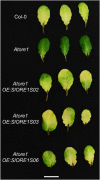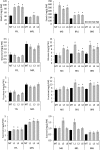Manipulation of a Senescence-Associated Gene Improves Fleshy Fruit Yield
- PMID: 28710129
- PMCID: PMC5580748
- DOI: 10.1104/pp.17.00452
Manipulation of a Senescence-Associated Gene Improves Fleshy Fruit Yield
Abstract
Senescence is the process that marks the end of a leaf's lifespan. As it progresses, the massive macromolecular catabolism dismantles the chloroplasts and, consequently, decreases the photosynthetic capacity of these organs. Thus, senescence manipulation is a strategy to improve plant yield by extending the leaf's photosynthetically active window of time. However, it remains to be addressed if this approach can improve fleshy fruit production and nutritional quality. One way to delay senescence initiation is by regulating key transcription factors (TFs) involved in triggering this process, such as the NAC TF ORESARA1 (ORE1). Here, three senescence-related NAC TFs from tomato (Solanum lycopersicum) were identified, namely SlORE1S02, SlORE1S03, and SlORE1S06. All three genes were shown to be responsive to senescence-inducing stimuli and posttranscriptionally regulated by the microRNA miR164 Moreover, the encoded proteins interacted physically with the chloroplast maintenance-related TF SlGLKs. This characterization led to the selection of a putative tomato ORE1 as target gene for RNA interference knockdown. Transgenic lines showed delayed senescence and enhanced carbon assimilation that, ultimately, increased the number of fruits and their total soluble solid content. Additionally, the fruit nutraceutical composition was enhanced. In conclusion, these data provide robust evidence that the manipulation of leaf senescence is an effective strategy for yield improvement in fleshy fruit-bearing species.
© 2017 American Society of Plant Biologists. All Rights Reserved.
Figures










Similar articles
-
The NAC Transcription Factor SlNAP2 Regulates Leaf Senescence and Fruit Yield in Tomato.Plant Physiol. 2018 Jul;177(3):1286-1302. doi: 10.1104/pp.18.00292. Epub 2018 May 14. Plant Physiol. 2018. PMID: 29760199 Free PMC article.
-
Tomato fruit ripening factor NOR controls leaf senescence.J Exp Bot. 2019 May 9;70(10):2727-2740. doi: 10.1093/jxb/erz098. J Exp Bot. 2019. PMID: 31002305 Free PMC article.
-
Molecular programme of senescence in dry and fleshy fruits.J Exp Bot. 2014 Aug;65(16):4515-26. doi: 10.1093/jxb/eru093. Epub 2014 May 29. J Exp Bot. 2014. PMID: 24874021 Review.
-
Solanum lycopersicum GOLDEN 2-LIKE 2 transcription factor affects fruit quality in a light- and auxin-dependent manner.PLoS One. 2019 Feb 12;14(2):e0212224. doi: 10.1371/journal.pone.0212224. eCollection 2019. PLoS One. 2019. PMID: 30753245 Free PMC article.
-
The interplay between ABA/ethylene and NAC TFs in tomato fruit ripening: a review.Plant Mol Biol. 2021 Jun;106(3):223-238. doi: 10.1007/s11103-021-01128-w. Epub 2021 Feb 25. Plant Mol Biol. 2021. PMID: 33634368 Review.
Cited by
-
Light and ripening-regulated BBX protein-encoding genes in Solanum lycopersicum.Sci Rep. 2020 Nov 6;10(1):19235. doi: 10.1038/s41598-020-76131-0. Sci Rep. 2020. PMID: 33159121 Free PMC article.
-
Spider Mites Cause More Damage to Tomato in the Dark When Induced Defenses Are Lower.J Chem Ecol. 2020 Jul;46(7):631-641. doi: 10.1007/s10886-020-01195-1. Epub 2020 Jun 26. J Chem Ecol. 2020. PMID: 32588284 Free PMC article.
-
Fruit-localized phytochromes regulate plastid biogenesis, starch synthesis, and carotenoid metabolism in tomato.J Exp Bot. 2018 Jun 27;69(15):3573-3586. doi: 10.1093/jxb/ery145. J Exp Bot. 2018. PMID: 29912373 Free PMC article.
-
NAC Transcription Factor Family Regulation of Fruit Ripening and Quality: A Review.Cells. 2022 Feb 2;11(3):525. doi: 10.3390/cells11030525. Cells. 2022. PMID: 35159333 Free PMC article. Review.
-
Multiple Layers of Regulation on Leaf Senescence: New Advances and Perspectives.Front Plant Sci. 2021 Dec 6;12:788996. doi: 10.3389/fpls.2021.788996. eCollection 2021. Front Plant Sci. 2021. PMID: 34938309 Free PMC article. Review.
References
-
- Almeida J, Asís R, Molineri VN, Sestari I, Lira BS, Carrari F, Peres LEP, Rossi M (2015) Fruits from ripening impaired, chlorophyll degraded and jasmonate insensitive tomato mutants have altered tocopherol content and composition. Phytochemistry 111: 72–83 - PubMed
-
- Almeida J, Azevedo MdaS, Spicher L, Glauser G, vom Dorp K, Guyer L, del Valle Carranza A, Asis R, de Souza AP, Buckeridge M, et al. (2016) Down-regulation of tomato PHYTOL KINASE strongly impairs tocopherol biosynthesis and affects prenyllipid metabolism in an organ-specific manner. J Exp Bot 67: 919–934 - PMC - PubMed
-
- Balazadeh S, Riaño-Pachón DM, Mueller-Roeber B (2008) Transcription factors regulating leaf senescence in Arabidopsis thaliana. Plant Biol (Stuttg) (Suppl 1) 10: 63–75 - PubMed
-
- Balazadeh S, Siddiqui H, Allu AD, Matallana-Ramirez LP, Caldana C, Mehrnia M, Zanor MI, Köhler B, Mueller-Roeber B (2010) A gene regulatory network controlled by the NAC transcription factor ANAC092/AtNAC2/ORE1 during salt-promoted senescence. Plant J 62: 250–264 - PubMed
MeSH terms
Substances
LinkOut - more resources
Full Text Sources
Other Literature Sources
Research Materials
Miscellaneous

